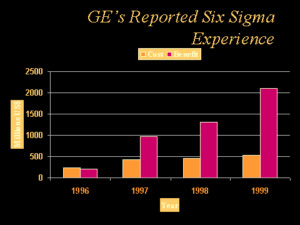Your cart is currently empty!
Six Sigma Frequently Asked Questions
The questions below are from various conferences where I have presented, from reader emails, and from conversations I’ve had with colleagues and clients. If you have a question that isn’t answered here, click the Contact button to send it to me. I can’t guarantee if or when I will be able to respond to your request. Advanced warning: I don’t have all of the answers! However, I’ll do my best.
Considering Six Sigma as cultural change, what is most needed to achieve full engagement from top management? What would you recommend?
Moving an average organization to Six Sigma does indeed require cultural change. And, yes, accomplishing this does indeed require the full engagement of top management. To accomplish this, we must remember that people in top management are no different than other people. Something motivates them to do the things they do, and if we want them to do something different, we have two choices:
1. Change the things that motivate them, or
2. Show them that Six Sigma can help them better accomplish the things they are already motivated toward.
It is my experience that item 1 is usually not within the realm of people in lower levels of management. Thus, I recommend that item 2 be pursued. It is not difficult to determine what motivates top management. Most senior leaders make it very clear what they hope to accomplish and when. Examine press releases, annual reports, the content of operations reviews, and especially budgets. Once the key drivers of senior leadership’s behavior have been identified look at companies that have pursued similar goals by employing the Six Sigma approach. Motorola, AlliedSignal, and GE are well-known benchmarks, but there are many others. Read the annual reports of these companies as well as the comments of stock market analysts. Next, research technical articles in quality and management journals for information on the results of deploying Six Sigma and TQM. Create a “story” showing how the Six Sigma approach will lead the company to the vision of senior leadership. Finally, seek any and every opportunity to tell this story to those in charge of the company. Better still, find senior leader champions inside and outside of your company to tell the story.
How can you calculate a number of sigmas for a non-stable process?
If you mean how can you predict the future performance of a process that is not in statistical control, you can’t. However, it is possible to calculate the historical sigma level for an unstable process by simply using a standard normal table and allowing for the 1.5 sigma shift do it now.
What are some of the results obtained by Six Sigma companies?

As mentioned above, GE is one of the benchmark companies for Six Sigma. The chart below shows the results GE has documented from their Six Sigma projects.
How much time does it take for a medium sized company to change their “bottom line thinking” to “statistical thinking?”
This question implies that there is an “OR” situation involved in choosing Six Sigma/statistical thinking. Either we pay attention to the bottom line OR we do Six Sigma. Actually, as the GE results shown above indicate, the situation is really an AND. There is a cause-and-effect relationship between the bottom line and Six Sigma. The situation is more accurately described by “We will use Six Sigma to make our bottom line grow.” In contrast to traditional cost cutting, Six Sigma makes the bottom line grow by zeroing on those costs of the organization, which add no value for customers, shareholders, or employees, i.e., waste costs. When waste costs are reduced, the results flow directly to the bottom line. In any event, it seems to take approximately three to five years for medium to large companies to reach maturity in the statistical thinking required by Six Sigma.
What is a Six Sigma Black Belt?
Six Sigma Black Belts are full-time change agents who work in Six Sigma or Lean Six Sigma. Black Belts work on entire value streams or cross-functional projects. Candidates for technical leader the Black Belt position are technically oriented individuals held in high regard by their peers. They should be actively involved in the organizational change and development process. Candidates may come from a wide range of disciplines and need not be formally trained statisticians or engineers. However, because they are expected to master a wide variety of technical tools in a relatively short period of time, technical leader candidates will probably possess a background in basic mathematics (e.g., algebra.) the primary tool of quantitative analysis. College-level course work in statistical methods is recommended, but not required. Successful candidates should understand spreadsheets, presentation programs and word processors. As part of their training they will be required to become proficient in the use of one or more statistical analysis software packages.
Do you need to apply Six Sigma to the entire organization? That is, does it involve the whole organization without exception or does it have to be applied only in operational areas?

Although Six Sigma may start in operational areas, mature Six Sigma organizations tend to deploy the approach throughout the entire organization. The reason is simple: the organization is a system. To reach Six Sigma levels of performance requires that the system itself be optimized. Local improvements will not deliver Six Sigma results where it counts, to the customer or shareholder. The figure below illustrates the principle of total system optimization for a manufacturing company. The idea is that neither local focus nor simple cross-functional focus will get to Six Sigma. Six Sigma requires a total system perspective.
You spoke about the number of hours needed to train Black Belts, Green Belts, and Master Black Belts. How many hours are needed to train leadership, management, and employees?
As the numbers in the table below indicate, the training provided to the various employee groups varies widely from one organization to the next. The answers provided here should be taken as rough rules-of-thumb based on my research. Organizations must adjust their training programs to respond to their own unique circumstances. For example, a service organization short of personnel qualified to take 160 hours of Black Belt training may provide 120 hours of training and employ a larger number of Master Black Belts than a typical firm to provide additional coaching.
| Group | Low | Typical | High |
|---|---|---|---|
|
Master Black Belts |
160 |
200 |
400 |
|
Black Belts |
80 |
160 |
240 |
|
Green Belts |
24 |
40 |
120 |
|
Senior Leadership |
8 |
24 |
40 |
|
Middle Management |
8 |
24 |
40 |
|
Hourly |
4 |
8 |
24 |
|
Team Members |
8 |
24 |
40 |
When Motorola made the smallest cell phone in the world, that was what the customers wanted. At the same time Nokia made the cell phone that customers didn’t ask for because they didn’t know. How can you balance in Six Sigma the dimensions standards, expectations and the future? Should Six Sigma focus on the client or on the market?
This is an excellent question. Deming made it a point that innovation is the only way to survive and prosper. This requires creativity and constant change. This in turn requires redundancy, slack, variability and a high tolerance for failure. Isn’t it strange that Six Sigma’s success requires that the organization encourage the very things that it is trying to eliminate? I call this the Six Sigma Paradox. For additional information click the Approach button on the left. You may also wish to read the article The Six Sigma Management Paradox.
I suppose that a return of $1 million/Black Belt/year is possible in a production process area. We are trying to improve business processes in our company, but the results are not having the same impact as in the production areas. Can Six Sigma guarantee results in administrative areas?
It is my experience and that of my clients that the payoffs in non-production areas is at least as great as in production areas, and often more so. Production areas are generally more advanced in the application of science to their work than administrative areas. Most administrative processes have not even been mapped or measured in the past. When Six Sigma methods are applied it is common to find enormous opportunities for improvement. For example, a purchasing team identified that over 95% of the time it took for processing a typical purchase order was non-value-added. Savings of this magnitude are rare in production areas. By the way, these comments also apply to service businesses.
Having said this, I don’t think Six Sigma can “guarantee” savings. The Six Sigma approach is a proven success in hundreds of organizations in all types of industries, including services, but it is not a panacea. However, any one company’s experience might be less than expected due to a variety of conditions. These conditions include the organization’s culture, its customers, its leadership, unique market conditions, etc.
What is the cost to implement a Six Sigma project?
The range of costs is so great that any definitive answer to this question is meaningless. Sometimes the cost approaches zero, as when one stops doing something dumb. (This is more common than you might think!) In other cases the Six Sigma project may require an investment of millions of dollars in order to reap the benefits. Six Sigma project costs are subjected to rigorous scrutiny by the organization’s finance experts during project approval. The costs must be justified by greater benefits, either in the form of a high return on investment for the project, increased customer loyalty, safety benefits, etc.
